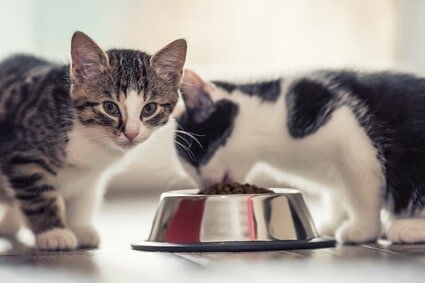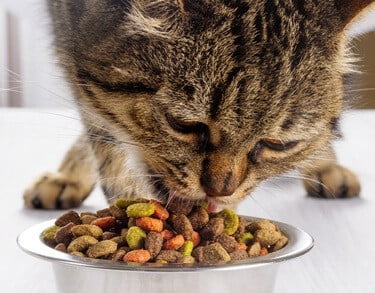Eating too quickly can be a common habit for cats. Due to territorial behavior, mood issues, and general medical conditions, they can speed up. No matter the case, eating too fast can lead to choking, regurgitation, difficulty breathing, and other harmful outcomes. So, it’s important to help your cat slow down its food consumption.
Solutions to a cat eating too fast include spreading out its food, adding obstacles, portion control feeders, and slow feeder bowls. You can also add water to meals, put your cat’s food in several locations, and offer smaller meals.
These tactics can be paired with each other. For example, you can spread out the food on a baking sheet and hide several of them around the home. You can add water to your cat’s food and offer several smaller meals throughout the day. If your cat eats wet food too quickly, you can spread it out more thinly across a bowl.
Is My Cat Eating Too Fast?
You’ll know your cat is eating too fast if it displays these symptoms:
- Coughing during or after eating
- Choking
- Vomiting or regurgitating after a meal
- Difficulty breathing after a meal
- Heavy breathing while eating
- Finishing an entire meal rapidly
When cats eat too fast, they’re more likely to regurgitate their meals soon after eating.
Eating too fast can also lead to obesity, increasing the chances of your cat developing various serious medical conditions, such as diabetes and arthritis.
If your cat vomits soon after devouring its meal, avoid feeding it immediately. It is best to wait at least 2 hours before offering your cat some water, and this gap will allow your cat’s gastrointestinal tract to rest.
What Happens When Cats Eat Too Fast?
You may think that eating too quickly is just a quirk of your cat. Some owners mistakenly allow this behavior to continue, believing it’s harmless. In truth, eating too fast can have serious repercussions.
Coughing during or after eating can mean that your cat has food stuck in its esophagus. Other than regurgitating undigested food, cats that eat too fast can choke on the food.
If your cat eats too fast and chokes, you should use your hands to gently push on its belly using quick, upward thrusts. Repeat this process about 5 times. If your thrusts don’t dislodge the choked food, hold your cat up by its back hips, bend its head downward, and gently sweep its mouth.
If your cat ate too fast and threw up, it’s because its stomach wall expanded too quickly and sent a signal to its brain to cause regurgitation. When a cat throws up after eating fast, it is just regurgitation and not vomiting.
According to the Journal of Feline Medicine and Surgery, this also happens when a cat has an esophageal injury.
Why Does My Cat Eat Really Fast?
Here are some common reasons why cats eat really fast:
Territorial Eating
Some cats eat fast when there are multiple pets in the household. The presence of others can threaten your cat, and as a result, it might develop territorial eating habits, such as food competition.
This is especially true if one can is dominant over the others. It might be hoarding the food, causing the other felines to gobble down as much as they can while the chance lasts.
Behavioral Issues
Behavioral issues that cause rapid eating may include depression, boredom, or loneliness.
A bored or lonely cat may eat quickly because it’s the only stimulation it has. A depressed cat may eat at a rapid pace to comfort itself. Usually, this habit develops over time.
Newly adopted cats may eat quickly due to a learned habit at their last home. Perhaps food was not readily available, or they often had to compete for it. This can lead to a compulsive need to eat as much as possible.

Underlying Medical Conditions
Certain conditions, such as hyperthyroidism and diabetes mellitus, can cause your cat to develop a ravenous appetite. If your cat recently started scoffing its food and didn’t exhibit such behavior previously, consult with your vet.
Parasites
Parasites like tapeworms are common in cats, attaching themselves to the intestinal walls and stealing the nutrients. So, your cat may not be receiving the nutrients it needs, causing it to eat more to make up the difference.
Addiction
Food addiction is more common in felines that are fed wet food exclusively. It may like the food’s taste, smell, and texture to the point of eating it compulsively, not just when it’s hungry.
If you’ve ruled out all other causes and had no success, try changing your cat’s food. This may include changing to a different brand or mixing dry food with wet food.
How to Slow Down a Cat from Eating Too Fast
Cats that eat too fast often experience discomfort, including throwing up, regurgitating, choking, coughing, and stomach upset. In the long term, such cats can also have difficulty with weight gain.
There are ways to encourage your cat to eat slower:
Spread Out The Food
A simple method is to avoid using traditional food bowls where all the food is piled in a small space. Instead, try spreading your cat’s meal out on a tray or baking pan. This way, your cat won’t gorge its meal up in one go.
Spread-out food will force the cat to move around each time it wants a mouthful. The cat will also get a smaller amount of food with each bite, making it difficult to swallow an excessive amount.
Add Obstacles
Adding obstacles to your cat’s food will make eating tricky. The cat will be forced to eat around the toys or other objects, getting a smaller mouthful of food than normal.
When adding obstacles, ensure they’re not small enough for your cat to eat. Instead, they should be small enough to easily nudge out of the way to reach the food.
You can use cat treat toys instead of traditional food bowls. These toys have food hidden inside, so your cat will have to nudge and push them around to access the food.
Automatic Feeder
According to the University of Cincinnati, feeder machines often help cats avoid regurgitation. Instead of giving one meal, they offer small portions on a schedule.
Only choose automatic feeders that include a portion-control option. If this feature is lacking, the device won’t serve any purpose for your fast-eating cat.
Strictly avoid those which dispense food merely whenever your cat interacts with it. Such kinds will encourage your cat to eat constantly, resulting in more regurgitation.
Slow Feeder Bowl
Slow-feeder bowls are designed with plastic shapes embedded in the bowls, working as obstacles. They spread the cat’s food out across these shapes, so the cat needs to angle its head and use its tongue to access the food.
Slow feeders not only present a challenge to cats and slow down their eating habits, but they also reduce the number of calories that a cat consumes daily.
This works best for overweight cats or those who tend to overeat.
Add Water to Meals
By adding water, the cat will become fuller quicker and may stop before it has finished the meal. Additionally, adding water to meals helps increase water intake, which is beneficial if your cat needs extra hydration.
Cats don’t have a strong thirst drive and will drink less water than the amount of food they eat. This can encourage some to slow down since eating and drinking will combine into one.
This method works best for cats prone to choking on their food. The added liquid can soften the dry food and help it go down easier. If the cat’s prone to overeating as well as eating quickly, the water will make it feel fuller for longer.
However, if your cat persistently eats at a fast pace, despite the water, this can raise the chances of regurgitation.
Hide Your Cat’s Food
Rather than placing your cat’s entire meal into its bowl, hide small amounts of cat food around the house.
This forces the cat to seek out the food rather than gorging in one place. It also allows your cat to take a breather in between meals, realizing it’s full quicker and avoiding regurgitation.
Likewise, the smaller portions hidden in each spot will make it difficult for your cat to overeat at each spot. Place the food across a tray instead of in bowls.
You can also use indoor cat hunting feeders designed specifically for this purpose. These devices come in mouse-shaped dishes that you can hide behind kitchen appliances and plant pots.
Offer Smaller Meals
For a hands-on approach, offer smaller meals throughout the day, rather than bigger meals one or two times. When meals are spaced out, and food is offered in smaller quantities, your cat can’t wolf down large amounts in one sitting.
This can prevent the cat from regurgitating and gorging itself. However, it can’t stop the cat from eating quickly, as it will merely swallow down these small meals at its usual pace.
How to Slow Down My Cat Eating Wet Food
Most cats are fond of wet food, and even the scent may cause them to eat it down too quickly.
To prevent this, spread wet food thinly across the bottom of a bowl, smashing it into a thin paste instead of large clumps. Your cat will spend its time licking to recover the food from the bottom.
This is a time-consuming process, forcing your cat to slow down.

